Understanding Why Horses Need Shoes for Health
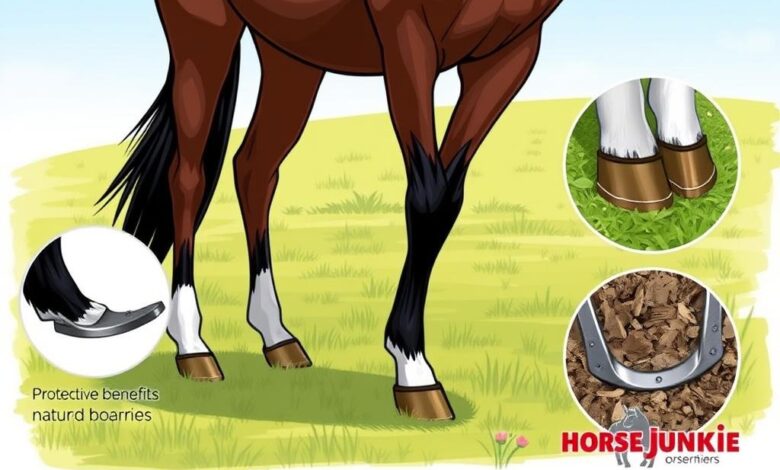
Ever wondered why some horses wear shoes while others don’t? This question is common among horse lovers. Horses need shoes for more than just looks; they’re crucial for hoof care and handling the physical demands of being a horse. Shoes protect, support, and last long, keeping hooves healthy and strong.
Horseshoes are key for safety and performance. They prevent injuries on hard or uneven ground and boost performance in high-impact activities. Each horse is different, needing specific care. We’ll look into the importance of horseshoes for keeping horses healthy and happy.
Key Takeaways
- Horseshoes are essential for protecting hooves from injuries.
- They improve traction and provide vital support for various activities.
- Different materials, including steel and aluminum, are used for crafting horseshoes.
- Certain conditions may necessitate corrective shoeing to enhance hoof health.
- Choosing to shoe a horse depends on the individual horse’s needs and activities.
The Anatomy of a Horse’s Hoof
Understanding a horse’s hoof is key to keeping them healthy. Each part of the hoof has a special job. Together, they help the horse move well and stay healthy. We’ll look at the hoof’s parts, how they work, and common issues.
The Structure of the Hoof
The hoof has several important parts:
- Hoof Wall: The outer layer, made of keratin, protects and supports.
- Sole: The underside shields the inside parts.
- Frog: A spongy area that helps absorb shock and grip the ground.
How Hooves Function
Hooves do many important things for horses:
- They support the horse’s weight and help them move.
- They give traction, keeping the horse stable.
- They absorb shock, reducing injury risk.
Common Hoof Problems
Horses can face many hoof issues without care:
- Cracks: Caused by dry conditions or lack of moisture.
- Abscesses: Infections that cause pain and discomfort.
- Sole Bruises: Injuries from hard surfaces to the sensitive tissue.
Regular care is vital to avoid these problems. It keeps the horse’s hooves healthy and supports their active life.
Reasons Horses Require Shoes
Horse shoeing is crucial for many horses. It protects them from injuries and boosts their performance. Each horse’s needs determine if they should wear shoes.
Protection from Injuries
Horses need shoes to avoid injuries. In places like the Rocky Mountains of Colorado, they can get hoof damage. Shoes offer extra protection, even in smoother areas.
Improved Traction
Shoes also improve a horse’s grip. They help horses stay steady on icy or slippery ground. This is especially important in fast-paced activities like racing.
Support for Hoof Health
Hoof health is a big reason for shoeing. Horses with issues like laminitis benefit from protective shoes. Regular visits to the farrier help keep their hooves in good shape.
Individual Needs Based on Activity
Every horse is different. Their age, work type, and environment affect if they need shoes. Some horses, like racehorses, need shoes every four weeks. A farrier can help find the right care for each horse.
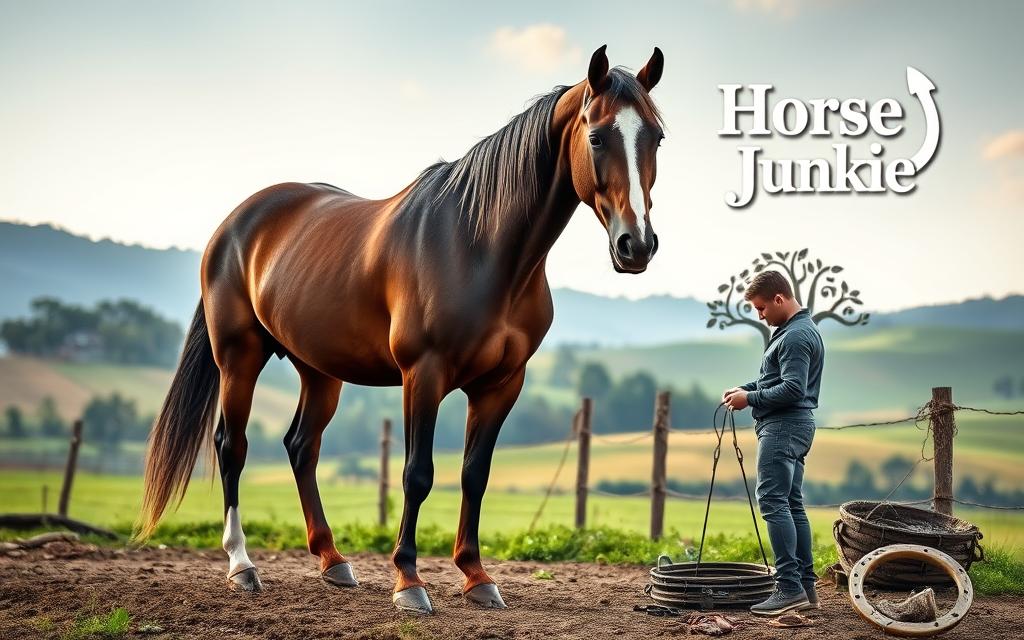
Types of Horse Shoes
Knowing about different horse shoes is key for good hoof care. Each type has its own purpose and benefits. The right shoe choice can greatly help in keeping hooves healthy and the horse well.
Standard Steel Shoes
Steel shoes are the most common choice. They are durable and support horses in daily activities. They protect hooves from damage, especially for horses doing roadwork or riding on rough terrain. Steel shoes last about four to eight weeks, keeping hooves in top shape.
Aluminum Shoes
Aluminum shoes are a lightweight option for performance horses. They are great for racing and high-speed activities. These shoes help horses run faster and be more agile, making them popular among competitive riders.
Specialty Shoes for Certain Conditions
Special shoes are made for horses with specific health issues. Heartbar shoes and rubber designs help with sensitive areas. They ensure comfort and let hooves grow naturally, showing our dedication to horse health.
Barefoot Alternatives
Some owners choose barefoot options like hoof boots and wooden shoes. These are cheaper and good for horses with healthy hooves. They let hooves move naturally, believing horses can do well without shoes.
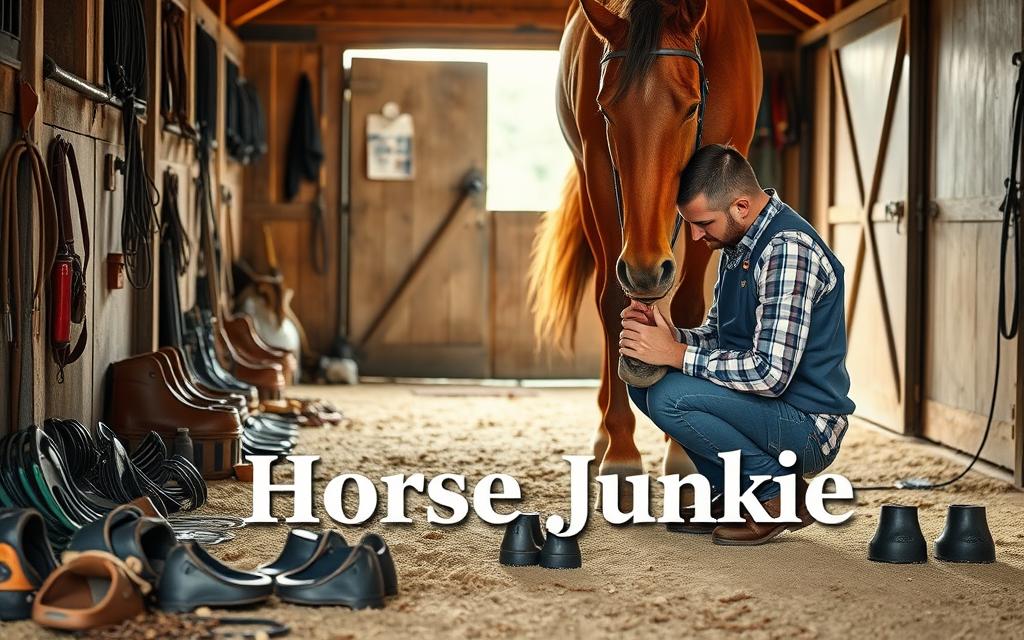
The Benefits of Shoeing Horses
It’s important to know how horseshoes help our horses perform well. The right shoes give them stability and support. This lets them move confidently on different surfaces.
Enhancing Performance
Good horseshoes can make a big difference in a horse’s performance. They help with speed, agility, and grip. This is key for horses to do well in competitions.
Reducing Lameness Risk
Horseshoes are great for keeping horses from getting l-a-m-e. They protect hooves from injuries. This keeps horses healthy and reduces pain.
Contributing to Longevity
Shoes are important for a horse’s long life. They help hooves handle tough terrains. Regular care and visits to the farrier keep hooves healthy.
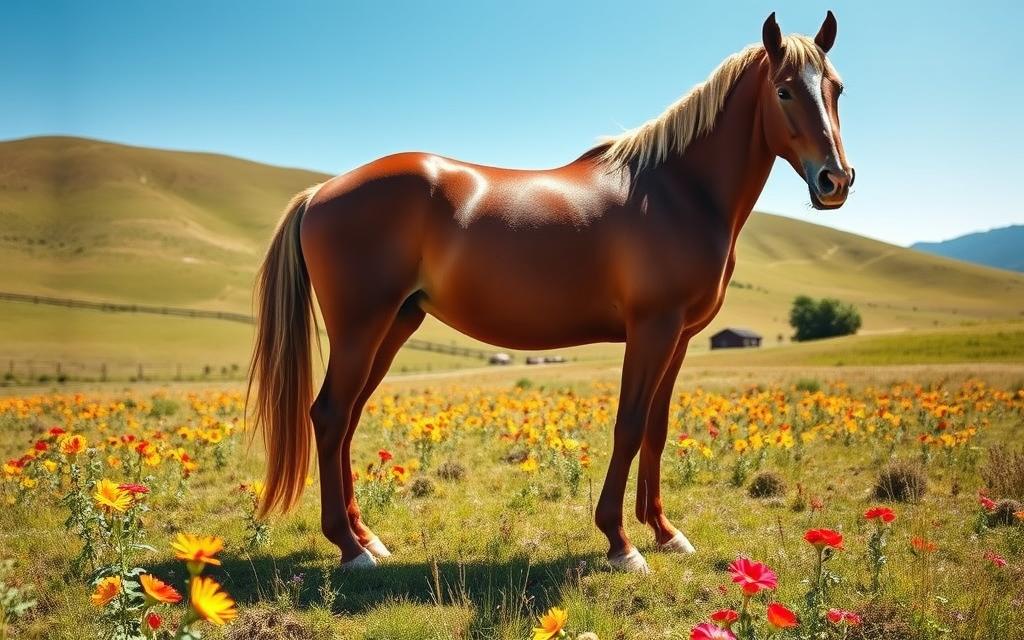
Signs a Horse Needs Shoes
Knowing when to shoe a horse is key for their hoof health. Watching them closely helps us see if they need shoes. This way, we keep our horses happy and healthy.
Observing Wear Patterns
Looking at hoof wear patterns tells us a lot. Uneven wear or too much smoothing means they might need shoes. For example, a Thoroughbred might show wear on bare hooves from riding on rough surfaces.
It’s important to notice these signs to make the right choice.
Understanding Behavioral Changes
Changes in behavior can show if a horse is uncomfortable. If they don’t want to walk or are hesitant on rough ground, they might need shoes. Keeping them barefoot can show their fitness, but sometimes shoes are needed for better grip and comfort.
Hoof Health Indicators
Checking for signs of hoof health is crucial. Look for cracks or uneven edges, which might mean they need shoes. If a horse’s feet look odd, it’s a sign something’s wrong and shoes might help.
Regular checks help us spot these signs early and decide when to shoe a horse.
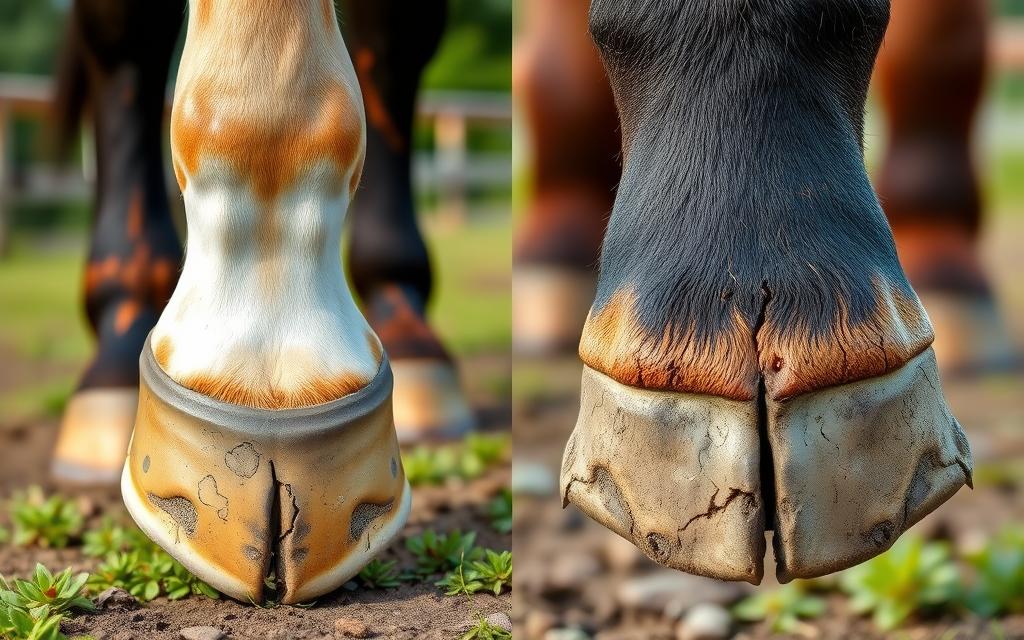
The Shoe Fitting Process
Knowing how to fit shoes is key for our horses’ hoof care. A skilled farrier must first measure and check the hooves’ health. They look at the size and wear patterns to pick the right shoe.
Measuring and Assessing Hooves
Measuring the hooves is the first step. We check their shape, size, and any deformities. This helps decide if shoes are needed or if barefoot is better. A healthy hoof is essential for our horses’ comfort and performance.
Selecting the Right Shoes
After measuring, we choose the right shoe type. Shoes can be made from steel, aluminum, plastic, rubber, or copper. We consider the horse’s activity and environment to pick the best material.
Application Techniques
Putting on shoes needs a lot of skill. Shoes must fit well to avoid discomfort or injury. A good farrier ensures the shoes are applied correctly, keeping the hooves healthy.
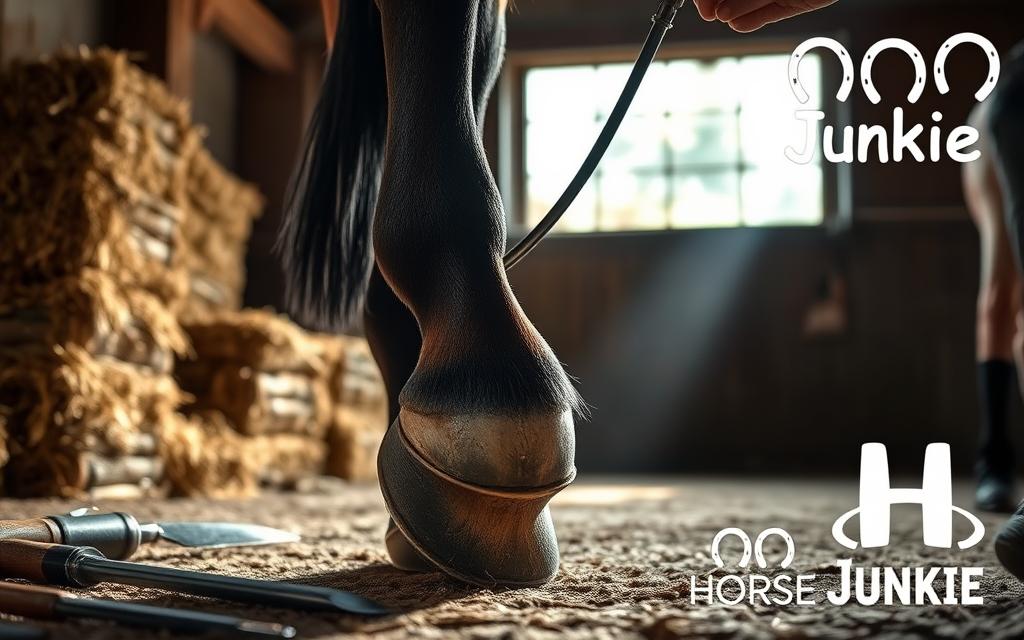
Maintaining Horse Shoes
Keeping horse shoes in good condition is key for our horses’ health and performance. Regular care helps their hooves stay healthy and work well. A consistent routine helps prevent pain and injuries.
Regular Inspections
Checking horse shoes and hooves regularly is crucial. Look for wear or damage signs. Focus on these key areas:
- Loose nails or shoes
- Uneven or thin shoe wear
- Cracking or splitting hooves
- Overgrown hoof edges
Scheduling Routine Shoeing
Farriers should see horses every 4 to 6 weeks. This keeps hooves trimmed and shoes fitting right. The schedule depends on the horse’s activity and where they go. Farriers adjust the shoeing based on the horse’s needs.
Identifying Signs of Damage
Being watchful is important for horse care. Look out for urgent signs like:
- Loose shoes or nails
- Twisted or misshapen shoes
- Abnormal wear on the hoof
Acting fast on these signs helps avoid bigger problems. It keeps our horses happy and safe in their daily activities.
Common Misconceptions About Horses and Shoes
When we learn about horses and shoeing, we often face many myths. These myths can affect how we care for a horse’s hooves. It’s important to know the truth about barefoot vs shod horses. Let’s look at some common misunderstandings.
Horses Are Better Off Barefoot
Many think horses do best without shoes. But, not all horses are better off barefoot. Things like where they live, how active they are, and their hoof health matter. We should think about these things before deciding on hoof care.
All Horses Need Shoes
It’s not true that every horse needs shoes. Each horse is different. Some do great without shoes, especially in the right places. Others need shoes for protection. Knowing this helps us understand hoof care better.
Shoeing Causes Pain
Many believe shoeing hurts horses. But, if a farrier is skilled, shoes don’t hurt. Shoes fit the parts of the hoof that don’t feel pain. It’s important to clear up the myth that shoeing is painful. Professional care is key to a horse’s health.
Transitioning to Shoes
Shoeing a horse is a big step that needs careful planning. We must make sure our horse is comfortable with the farrier and the shoeing process. Getting our horse ready for shoes helps with comfort and effectiveness.
Preparing the Horse for Shoeing
Comfort is key when shoeing a horse. We should make a calm space for our horse. This lets it get used to the farrier’s tools.
Familiarizing our horse with the farrier reduces stress. It’s important to watch our horse’s body language for signs of anxiety or discomfort.
Adjusting to New Shoes
After shoeing, our horse needs time to get used to the shoes. Each horse is different, so we must watch for any changes in behavior. Checking for signs of discomfort or an unbalanced gait is crucial.
Gradually increasing the time our horse spends in its new shoes helps with adjustment.
Ensuring Comfort Post-Shoeing
After shoeing, taking care of our horse is just as important as preparing it. We should watch our horse for a few days to see how it adapts to the shoes. Looking for chipping or cracking in the hooves is part of proper care.
Resting our horse after removing the shoes helps with recovery. This can greatly improve our horse’s overall health.

The Role of the Farrier
A farrier is key to keeping our horses healthy. They give expert hoof care and fit shoes. This ensures our horses stay sound and perform well.
Proper hoof care is vital. A skilled farrier is essential for this. Their knowledge is priceless for horse owners.
What a Farrier Does
A farrier does several important tasks:
- Trimming hooves to prevent overgrowth
- Fitting shoes based on the horse’s specific needs
- Assessing hoof health and identifying potential problems
- Providing recommendations for proper hoof care and maintenance
Regular visits, about every six weeks, are needed for best hoof care. Shoeing costs around $150 per horse. Each visit lasts about an hour.
This is crucial for horses that do a lot of work or ride on rocky paths.
How We Choose a Good Farrier
Choosing a farrier is a big decision. It affects our horse’s health. We should look at:
- Qualifications and certifications in equine podiatry
- Experience with various horse types and shoeing techniques
- Ability to understand the individual needs of our horse
- Communication skills for effective collaboration
Choosing the right farrier is worth it. It keeps our horse’s hooves healthy and prevents problems. Some breeds, like Clydesdales, need special shoes because of their size.
Building a Relationship with Our Farrier
Having a good relationship with our farrier is important. Open communication helps us share concerns. It also lets us talk about our horse’s behavior and performance.
This dialogue helps us follow the best hoof care practices. A strong relationship means our horse’s well-being is a shared goal. This reduces the chance of shoeing mistakes that can hurt our horse.
Working together in equine podiatry keeps our horses healthy and sound. They will thank us for it.
Impact of Environment on Hoof Health
The environment greatly affects horse hoof care. It impacts the health and condition of a horse’s hooves. Knowing how surfaces and seasons change hoof health is key. This knowledge helps us make better decisions about shoeing and care.
By being proactive, we can manage our horses’ hoof care better. This is especially true for their unique environments.
Effects of Different Surfaces
The surface horses walk on can greatly affect their hooves. For example:
- Soft ground may be less harsh but can cause thrush in wet conditions.
- Hard or rocky terrains require protective measures, like horseshoes, to prevent wear and injury.
- High-quality surfaces, like rubber or sand, cushion hooves and joints.
Seasonal Changes and Their Effects
Seasonal changes bring challenges to hoof care. Important points include:
- In cooler climates, hoof growth slows, needing less trimming.
- Warmer climates require more frequent trimming due to faster growth.
- Wet conditions can soften hooves, increasing infection risks, like thrush.
Managing Hoof Care in Various Conditions
To keep hooves healthy, we must adjust our care based on the environment. Considerations include:
- Using pour-in pad materials like Equi-Pak or Equi-Pak Soft for support and protection all year.
- Watching hoof conditions closely during seasonal changes to spot issues early.
- Talking to farriers and vets about specialized shoes or pads based on environment.
Future Trends in Equine Hoof Care
The world of equine hoof care is changing fast. New ideas and a better understanding of horse health are leading the way. We’re seeing big steps forward in shoe technology, making horses perform better and feel more comfortable.
These new shoes are made with lighter materials and are designed for specific needs. They’re not just about lasting longer. They also help keep our horses healthy and happy.
Innovations in Horse Shoe Technology
New horse shoe technology is bringing exciting changes. For example, FormaHoof Application helps spread a horse’s weight evenly. This improves blood flow and helps the hoof grow naturally.
Experts also stress the need for regular shoe checks. Horses should see a farrier every six weeks. This keeps their hooves in top shape and prevents problems.
Embracing Natural Alternatives
There’s a big move towards natural hoof care. People are focusing more on keeping a horse’s hooves in their natural state. Studies show that barefoot hooves have many benefits.
DVM Veron Dryden points out that natural hooves can expand better than shod ones. But, switching to barefoot hooves needs to be done slowly. We must manage their workload carefully to avoid pain.
The trend towards natural care includes a balanced diet and proper trimming. It also involves using supportive products like hoof boots.
The Growing Importance of Hoof Health Education
Learning more about hoof health is key. It helps us make better choices for our horses. By understanding their needs, we can decide if they need shoes or not.
This focus on education is crucial. It shows how important it is to get professional advice. With this knowledge, we can ensure our horses have healthy hooves and are happy.
FAQ
Why do horses need shoes?
What are the benefits of horseshoes?
When should I shoe my horse?
What are common hoof problems that require attention?
How often should horseshoes be maintained or replaced?
Are there alternatives to traditional horseshoes?
Can horses be comfortable without shoes?
What should I look for in a farrier?
How does the environment affect horse hoof health?
What are common misconceptions about horses and shoes?
Source Links
- Do horses need shoes? The pros and cons of shoeing
- Why does a horse need shoes? – Equestrian Surfaces Ltd –
- Ask a Farrier: Do Horses Really Need Shoes?
- How is a hoof also a shoe?
- The Hoof: Shoeing and Trimming
- When You Should Shoe Your Horse | Cave Creek Equine™
- Should Your Horse Wear Shoes or Go Barefoot?
- The Different Types Of Horseshoes | Strathorn Farm Stables
- Why Do Horses Need Shoes?
- Shoes for Horses: Everything You Need to Know
- Why does your horse wear hind shoes?
- Why Do Horses Wear Shoes?
- How can you tell when your horse needs shoes?
- How To Know If Your Horse Should Wear Shoes
- Why Do Horses Need Shoes – The Pet Staff
- Why Do Horses Need Horseshoes?
- Why Shoe Horses? | Butler Professional Farrier Schools
- How Often Do Horses Need New Shoes: 4-Step Process for Shoeing a Horse
- Why Do Some Horses Need Shoes, But Cows Don’t?
- 19 Horse Myths and Misconceptions That It’s Time to Stop Believing | PangoVet
- 8 Hoof Care Myths
- Five Horse Hoof Care Myths — Mossygoat Farm
- Back to Barefoot: Managing Horses Sans Shoes
- I transitioned my horses to barefoot. Here’s what…
- Transitioning Your Horse: Taking The Shoes Off? How to Plan For Barefoot Success
- Horse Shoes and the job of the farrier
- Why do horses wear shoes?
- Environmental Factors: How Weather and Temperature Affect Hoof Health
- A Guide to Horse Hoof Care
- Why Do Horses Need Shoes? The Connection Between Shoes & Flooring
- Barefoot Transition: Comprehensive Guide
- Flat Footed Horses – Shoes Always Necessary?






